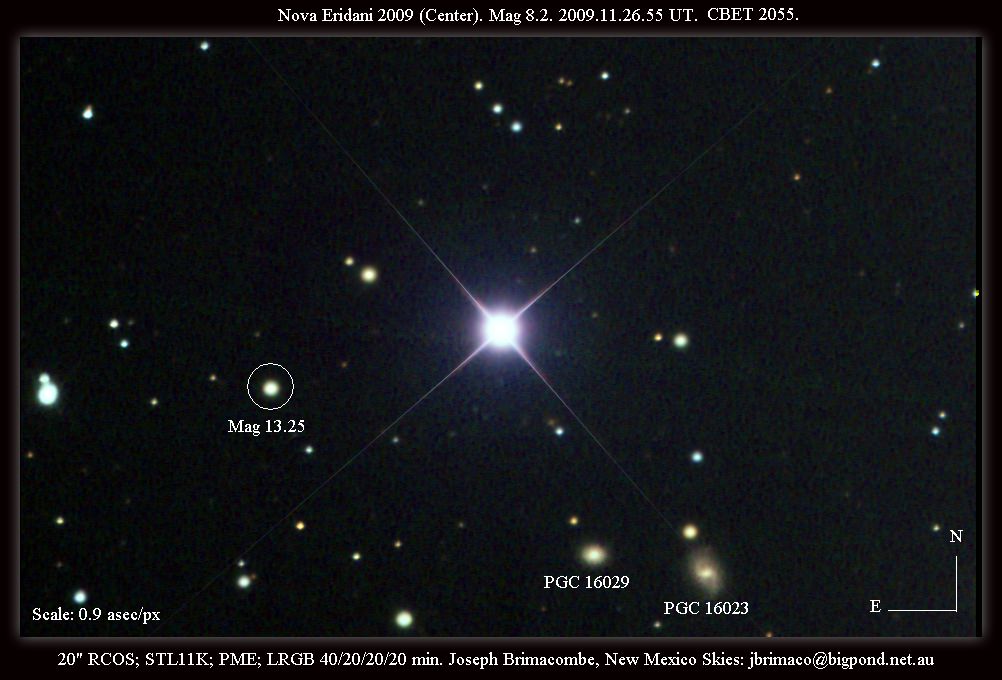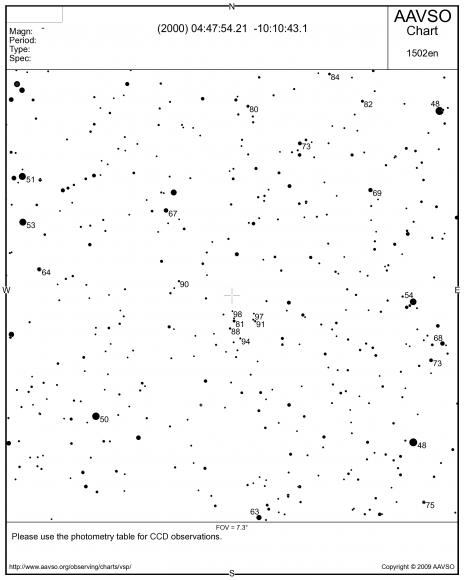K. Itagaki of Yamagata, Japan was photographing the night sky in Eridanus two days ago when Hitoshi Yamaoka of Kyushu University noticed an anomaly – a possible classic nova event. Just how big a jump in amplitude did this star make? Try at least seven magnitudes within hours… and Joe Brimacombe was on it.
According to AAVSO Special Notice #181 released on November 25, 2009, there could be a possible nova in Eridanus. “Central Bureau Electronic Telegram No. 2050 (Daniel W. E. Green, Ed.) announces the discovery of a possible nova in Eridanus, as reported by Hitoshi Yamaoka, Kyushu University, by K. Itagaki, Yamagata, Japan, at magnitude 8.1 on images taken Nov. 25.536 UT. The object was confirmed by Itagaki on an image taken on Nov. 25.545.
Coordinates: R.A. = 04:47:54.21 Decl. = -10:10:43.1 (equinox 2000.0)
According to CBET No. 2050, “Itagaki notes that there is a faint (mag about 15) object near this position on his archival patrol images. Yamaoka suggests that it might be the brightening of a 15th-mag blue star that is contained in many catalogs (USNO-B1.0 position end figures 54s.19, 42″.9), noting that the amplitude of seven magnitudes is rather large for a dwarf nova, but somewhat small for a rapid classical nova. Yamaoka adds that the ASAS-3 system (Pojmanski 2002, Acta. Astron. 52, 397) also detected this object at the following V magnitudes: Nov. 10.236 UT, [14.0:; 19.241, 7.34; 22.179, 7.98; 24.269, 8.12.” Finder charts for this object may be plotted using VSP by entering the coordinates into the form at the this URL.
This object has been assigned the VSX identifier VSX J044754.2-101043. An AUID will be assigned by the VSX moderators and will be added to the on-line version of this notice when it becomes available. Please report observations to the AAVSO International Database as N ERI 2009 or VSX J044754.2-101043.”
Within 24 hours even more news came in via AAVSO Special Notice #182:
“This new variable object in Eridanus, originally called a possible nova in CBET 2050, is most likely a WZ Sge variable. It matches closely the coordinates of GSC1.2 05325-01837, listed in that catalog at 14.76 mag. At the peak outburst magnitude of 7.3, this is about 7.5 magnitudes amplitude, within the range of a galactic variable and lower than a typical nova. It appears to be fading and is about V=8.5 right now. However, WZ Sge cataclysmic variables have a complex light curve and the star may re-brighten. We are awaiting spectral
confirmation and possible GCVS naming, and will pass on that information as soon as possible.
As mentioned in Special Notice 181, the star has been entered as VSX J044754.2-101043 and now has an AUID of 000-BJR-847. You can submit observations to the AAVSO with either identifier. We have a preliminary sequence from Mati Morel, and have obtained BVRI imagery using the Bright Star Monitor at Astrokolkhoz Observatory
which we will use to construct a multiwavelength sequence tomorrow (November 27).
This is a good target for time series photometry, and at its current brightness, we highly recommend using filters. Larger telescopes should consider B or even U filters.”
Congratulations to K. Itagaki on his latest discovery, to AAVSO for pinning it down and to Joe Brimacombe for his quick imaging of the phenomena!



I don’t know what a WZ Sge variable is, but it looks as if we might get to observe the formation of a nice planetary nebula here.
LC
@ Lawrence Crowell, WZ Sagittae variables form a class of cataclysmic dwarf novae that are seen to reoccur periodically during periods of outburst or so-called ‘superoutbursts’ ( Wiki offers a good summary here: http://en.wikipedia.org/wiki/WZ_Sagittae ). As mentioned in that link WZ Sze is observed to display superoutbursts only, a feature that may be related to magnetic effects within the system.
What I find interesting with these CVs is the periodic re-brightening seen to occur during outbursts or superoutbursts. As the above article notes, observers should be on the lookout for any rebrightenings, which may occur over the next few days or weeks before a more regular dimming phase ensues (I plan to go have a look with my telescope over the coming days (or weeks).
Astronomers (both amateur and professional) will be checking archival plate or image collections to see if any previous outbursts (or superoutbursts) may have been missed. Harvard College Observatory plates of this area probably exist dating to the early 1890s, though images taken by amateurs over the past few decades may also have caught this star in a previous flare-up.
Thanks for the information. I am aware that some dwarf stars exhibit a lot of flaring. Dwarf stars don’t seem to be the tamest things in the world.
LC